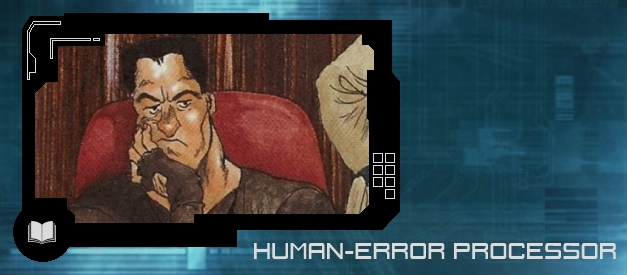
With the first manga, we were introduced to another style of cyberpunk from a Japanese perspective chockfull of police cases packed with action where offensive and defensive strategies can be won with cyber tactics acting as a weight to tip the scales in your favor. Balancing that out were a sprinkling of philosophical discussions about the distinctions between humans, cyborgs, and robots and related issues regarding artificial intelligence. The ending brings up these issues front and center and includes two characters discussing the matter, bring an intelligent conversation to the subject. This was the perfect combination of smarts and action to make it a successful hit.
The second book, Man-Machine Interface, decided to go further in the direction of smart discussions by having the focus of the book be more about the blurring between artificial intelligence and humans. Because of this the action was brought to a minimum, being used somewhat as a way to separate long conversations of dialog and to have a few pages include little to no word bubbles. Some consider this to be Masamune's best book, but at the same time I can also understand why some fans of the original manga weren't so willing to accept it as a Ghost in the Shell book. Makes sense since it doesn't even include the old Section 9 team.
So if that was a concern, then consider the balance having been restored as the third book, Ghost in the Shell 1.5: Human-Error Processor, goes the other way by changing the focus back to Section 9 and following their adventures as they solve cases without Major Kusanagi to act as leader.
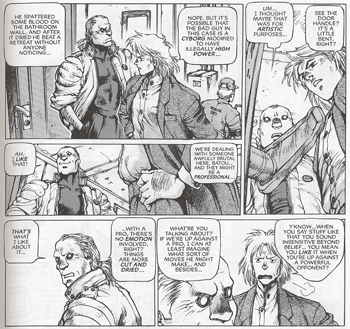
Regarding the timeline, the stories in Human-Error Processor take place after the events from in the first book, but before those in the second; hence the 1.5 in the title. In the vacuum she created due to her leave of absence, it seems like it takes three members to fill that void to make up for what she brought to the group: Batou with his combat strategy, Aramaki for his administrative role, and Togusa for his skills in solving puzzles in a case. Of course these were reasons why each were brought on to the team in the first place, but it's like each has to now contribute more to make up for the loss of the group's leader.
But with one man down, Aramaki decided to recruit a new member for S9, so with this we get the introduction to a new character named Azuma. Compared to everyone else, he's quite the character, a jokester who yucks things up to keep it from getting too serious. He's shown for the first time on the first page for the first chapter in the book titled "Fat Cat." In it, we have a case where an important person is dead, but his body is being controlled remotely by an unknown assailant in order to get the dead man to sell his fortunes. Seeing odd behaviors in her father, she asks Section 9 for assistance as her dad told her to seek them out if she needed any help as Aramaki is a friend of his. Togusa and Azuma are partners in this case, so we get a good intro for the newcomer.
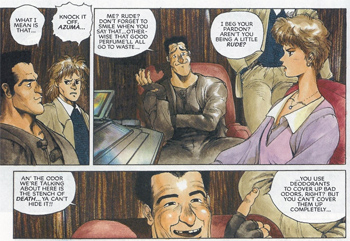
In the way that it's portrayed, Togusa looks to be primary character in this book, replacing the Major in her absence. Yeah, Batou has a lot of scenes too, but I think Togusa is shown a bit more I guess due in part because of how the narrative follows more of a detective style minus the inner monologue one normally has with it. Add in the fact that there are lesser heavy military styled attacks and being replaced with small arms weapons with handguns, fitting the tone of being more about solving cases on a more grounded realty than over the top action.
And while Togusa is good at coming up with ideas to solve cases, they are solved in a sloppier, less efficient manner when compared to when the Major was in charge. Something would cause a wrench to be thrown in his efforts, causing him to look foolish and later being grilled by Aramaki for it when he gets back to the office. It could be that Aramaki is training Togusa to be the new leader if the Major doesn't return to Section 9. That or he's grooming him to take his place as the man in charge of S9 when Aramaki ever decides to step down.
The chapter "Drive Slave" is used as a comparison to how important a skilled person for the role of leader can be when it comes to solving a case or when getting out of a rough situation. It's in this chapter that we see the Major, now acting solo on her own missions separate from Section 9 and Public Security all together, crosses paths with them when her mission is intertwined with Section 9's case involving a company named Micro Telemeter Corporation where there's a problem regarding defects in the company's micromachine technology. While Togusa and team are protecting a whistleblower for the defect scandal, Major Kusanagi -- currently under the alias Chroma -- is working on a kidnapping case where the lover of a scientist at Micro Tele Corp was taken because she's come across on some info relating to the defect scandal.
When she meets up with S9, trouble comes a knocking at the front of the hospital when the group trying to silence the whistleblower comes crashing in with a large, thick plated robot with the kidnapped woman in the cockpit unconscious and having her cyberbrain controlled remotely into piloting the robot. With the Major's help, they were able to stop the robot, rescue the kidnapped person, get the whistleblower to safety, and have Kusanagi escape without anyone knowing where she went to. It was short lived, but as a fan of the series, it's great seeing the group back together for at least one more mission.
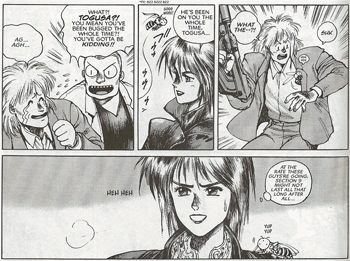
While Man-Machine Interface was drawn beautifully with computer generated assets, Human-Error Processor goes back to the old-school, hand-drawn stylings seen from the first manga; although with improvements found in Masamune's technique. All of the pages are in black and white with the exception of a few at the beginning of each chapter that are in color. Character designs look to have more details drawn in with loads more lines and shaded areas, but all still got that anime look to them except for Aramaki who has a more of a realistic aspect to this head and face. In the first book he had a mouth that had similarities to an ape while here those features have been toned down. While it's an improvement, there are some angles that Masamune poorly chose where his face comes out looking more oval than it should.
This is also the first book where it keeps the traditional manga style that is read from right to left. The first two books were "Americanized" where all of the pages were mirror flipped so it could be read from left to right.
Based on the dates found on Wikipedia, I believe Human-Error Processor ran at the same time as Man-Machine Interface did throughout the 1990s. If I had to guess, I'd say each HEP chapter was released between each chapter from MMI, acting as supplemental stories leading up to MMI. Although, very detached from the events that occurred in the second book.
Going back to Azuma, he's one of those characters who has two strong personalities. When he's acting goofy his physical traits get sillier too, but when he's serious the details get filled in. His face has sharp lines only second to Paz. He has a squared jaw, long chin, cheekbones, thick eyebrows, pointed nose, black hair with long sideburns, and an exaggeratedly tall flattop with a widow's peak. His specialty to the group is having a strong scent to pick up smells others may have missed and the ability to spot things from a distance.
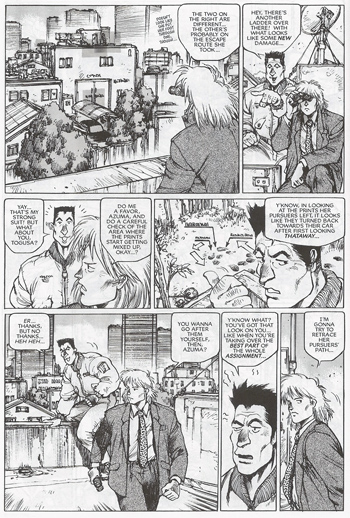
There's some good action spread throughout to keep the guns blazing in every chapter. Unlike MMI where most battles were done through the cyber world, these were real world battles where lives are on the line. Not those "I'll remotely control a prosthetic body so no risk is involved" kind of fights that we saw Motoko Aramaki perform. Snipers, biker thugs, and more will be the kind of criminals that challenge Section 9 when they come on scene.
While being the shortest book of the three, it's crammed with enough content to keep you satisfied. The cases are deep, following the team as they chase down clues to take them closer to who's behind the crime. If you were disappointed by what you saw in MMI, then check out this book. If you were cool with MMI but want more GitS styled detective work, then you still won't be disappointed by what's here.
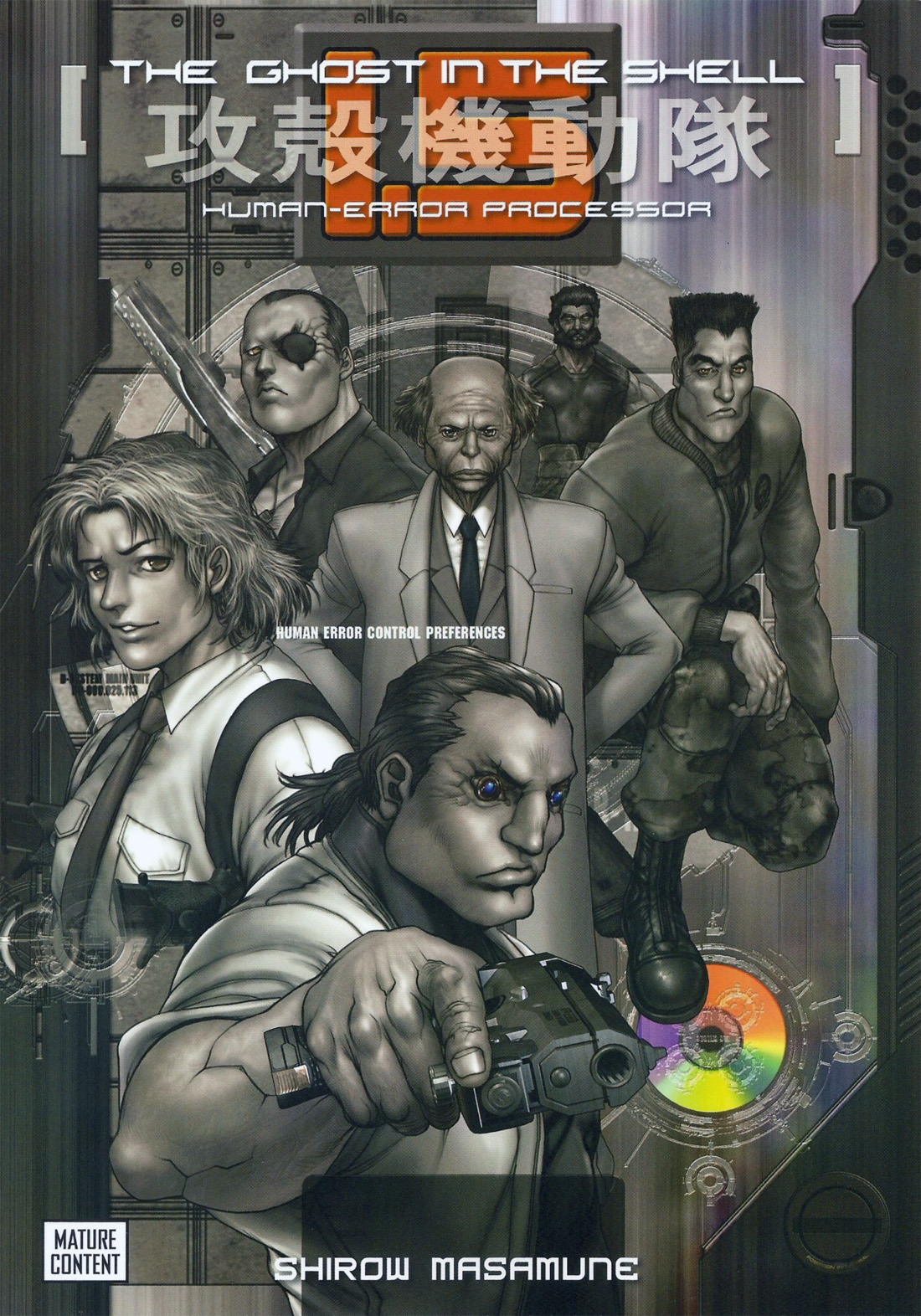 |
Ghost in the Shell 1.5: Human-Error Processor
JP Original Print: 1991 US Release: 2007 176 pages |
Posted on: February 16, 2017
